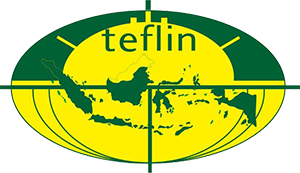Technology Effect of EFL Listening Comprehension to Teacher during Pandemic
Abstract
Full Text:
PDFReferences
A, G., Haolader, F. A., & Kushi, M. (2013). The role of ICT to make teaching-learning effective in higher institutions of learning in Uganda. International Journal of Innovative Research in Science, Engineering and Technology, 2(8), 4051–4073.
Aferbach, P., P. D. (last), & Paris, P. (2017). Skills and strategies: Their diferences, their relationships, and why they matter. (Improving reading comprehension through metacognitive reading strategies instruction). Rowman and Littlefeld.
A.N. Knoop-van Campen, C., Carolien A.N. Knoop-van Campen a,*, Segers, E., & Verhoeven, L. (2020). Effects of audio support on multimedia learning processes and outcomes in students with dyslexia. Computers & Education. https://doi.org/10.1016/j.compedu.2020.103858
Anggraita, N. F. (2012). The Influence of Students’ English Learning Attitudes on Their English Learning Achievement of The Eleventh Grade Students of State Vocational High School 4 Purworejo in the Academic Year 2011/2012.
Arifah, Y. (2012). The Correlation Between Student’s Mastery of Past Tense and Their Ability in Writing recount: A Case Study at The First Grade of MAN Purworejo in The Academic Year.
Arikunto, S. (2010). Prosedur Penelitian: Suatu Pendekatan Praktik. Jakarta: PT. Rineka Cipta.
Balash Farhad, Young Zang, & Abu Bahrain. (2011). Lecturers and ET: Factors affecting ET adoption in teaching. 2nd International Conference on Education and Management Technology IPCSIT, 13.
Chen, X. (2020). Pragmatic Identity: How to Do Things with Words of Identity. East Asian Pragmatics, 5(2), 279–284. https://doi.org/doi.org/10.1558/eap.40442
Daru Santoso, S., Sunjayanto Masykuri, E., Widiyono, Y., & Sholeh, K. (2018). Does Sony Vegas Platinum Pro 13 Help Students to Understand Pragmatic Well? International Seminar On Recent Language, Literature, And Local Culture Studies (BASA 2018, 280. https://www.atlantis-press.com/proceedings/basa-18/25906104
Delsa, M., & R, D. (2016). Delsa, M & Diana R. 2016. Designing Podcast For Students: A Prototype For Teaching English In Listening Class. The Journal of English Language Studies, 1(2), 105–120.
Eggins, S. (1994). An Introduction to Systemic Functional Linguistics. Pinter Publishers Ltd.
Emilie, G., Gerard, B., & Marie Line, B. (2017). Audio-visual synchronization in reading while listening to texts: Effects on visual behavior and verbal learning. Computer Speech & Language. https://doi.org/: 10.1016/j.csl.2017.07.003
G, A. (2017). Podcast at School: Fostering Listening Comprehension Skill Using Podcast with Eighth Graders. Faculty of Education Bachelor of Arts in English Language Teaching.
H, H., Warsono, A., Angraini, A. L., & Jatmika, S. (2021). H. Hamidiyah, Warsono, A. I. Anggraini, and S. Jatmika, “The Implementation of Whiteboard Animation Video Based on Local Wisdom in Work and Energy Concept to Improve Senior High Schools Students’ Learning Interest,” in Proceedings of the 6th International Seminar on Science Education (ISSE 2020), 2021, vol. 541,. International Seminar on Science Education (ISSE 2020). https://doi.org/10.2991/assehr.k.210326.079.
I. A. R., A., M. A. S, A., & A. M., M. (2012). A correlation study between EFL strategic listening and listening comprehension skills among secondary school students. Benha Faculty of Education Journal, 23(1), 1–26.
Jelisaveta, S. (2014). Advancing Listening Comprehension Through Movies. Procedia, 169–173.
Khabib Sholeh, M., Baguya, B., & Nur Aini, F. (2020). Pengaruh Media Cetak dan Audio Visual terhadap Kemampuan Menulis Teks Berita pada Siswa MTs Bergaya Kognitif Field Dependent dan Field Independent. Jurnal Pendidikan Surya Edukasi, 6(1), 33–48.
Khan Kakar, S., & Hussain Pathan, Z. (2017). Exploring the Motivational Strategies Practiced by Pakistani EFL Teachers to Motivate Students in Learning English Language. International Journal of English Linguistics, 7(2), 117–123. https://doi.org/10.5539/ijel.v7n2p117
khotimah, K., Masykuri, E. S., & Istighfarin. (2017). Combining New Technology in ELT to Create Innovation in Student’s Learning. Seminar Nasional Bahasa, Sastra, dan Budaya, Universitas Muhammadiyah Purworejo, Indonesia.
Kusuma, I., Ngafif, A., & Sunjayanto Masykuri, E. (2021). E-Learning Usage Analysis in English Language in Universitas Muhammadiyah Purworejo. Scripta The English Department Journal, 8(2), 35–44. https://doi.org/https:/doi.org/10.37729/scriptav8i2.1136
Masykuri, E. S. (2013). Operating Android by Tapping Google Map Apps to Learn Direction In Vocational School. UNIVERSITAS MUHAMADIYAH PURWOREJO, 1(1), 112.
McVee, M. B., Shanahan, L. E., H. E., Pearson, P. D., & Reichenberg, J. S. (2018). Video pedagogy in action: Critical refective inquiry using the gradual release of responsibility model. Roudlege.
Meyerhuber, S. (2019). Active Listening’ as a Key Competence in Intercultural Education. Journal of Linguistics and Intercultural Education (JoLIE), 2, 91–114.
Mhd Rodzi, N., Amantha Kumar, J., Osman, S., & Masykuri, E. S. (2020). Exploring Lecturers’ Acceptanceof Learning Management Systems in Malaysian Higher Educational Institution. EAI, 5. https://doi.org/dx.doi.org/10.4108/eai.28-9-2019.2291064
Nurhadi, R., & Masykuri, E. S. (2020, May 4). Symbol Meaning and Dialectic Perspectives on Social Media. Proceedings of the 1st Borobudur International Symposium on Humanities, Economics and Social Sciences (BIS-HESS 2019), Magelang, Indonesia. https://doi.org/10.2991/assehr.k.200529.234
Parapi, J. M. O., Maesaroh, L. I., Basuki, & Masykuri, E. S. (2020). Virtual Education: A Brief Overview of Its Role in The Current Educational System. Scripta The English Department Journal, 7(1), 8–11.
Sadikin, A., & Hamidah, A. (2020). A. Sadikin and A. Hamidah, “Pembelajaran Daring di Tengah Wabah Covid-19:(Online Learning in the Middle of the Covid-19 Pandemic),” BIODIK J. Ilm. Pendidik. Biol., vol. 06, no. 02, 2020. BIODIK JIlm. Pedidikan Biol, 6(2).
Sugiyono. (2019). Metode Penelitian Pendidikan Pendekatan Kuantitatif Kualitatif dan R&D.
Sunjayanto Masykuri, E., & Thien Wan, A. (2020). PEMBELAJARAN DI MASA COVID-19 WORK FROM HOME: PEMBELAJARAN KETERAMPILAN BAHASA INGGRIS DENGAN PENGGUNAAN BEBERAPA APLIKASI BERBASIS ANDROID DAN WINDOWS (pp. 86–92). Whineka Media.
Twyman, J. S., & Heward, W. L. (2018). Twyman, J. S., & Heward, W. L. (2018). How to improve student learning in every classroom now. International Journal of ducational Research, 87, 78–90. Https://doi.org/10.1016/j.ijer.2016.05.007. International Journal of Educational Research, 87, 78–90.
Wright, A. (1989). Wright, Andrew. (1989). Visual Materials for The Language Teacher. England: Longman Group Ltd. Longman Publishing Group.
DOI: http://dx.doi.org/10.21043/jetli.v5i1.13913
Refbacks
- There are currently no refbacks.
Copyright (c) 2022 Edi Sunjayanto Masykuri







